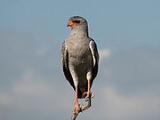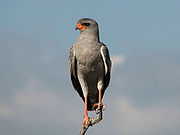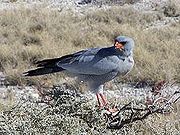
Pale Chanting Goshawk
Encyclopedia
The Pale Chanting Goshawk (Melierax canorus) is a bird of prey
in the family Accipitridae
.
This hawk
breeds in southern Africa
. It is a resident species of dry, open semi-desert with 75 cm or less annual rainfall. It is commonly seen perched on roadside telephone poles.
 This species is 56–65 cm long. The adult has grey upperparts with a white rump. The central tail feathers are black tipped with white, and the outer feathers are barred grey and white. The head and upper breast are pale grey; the rest of the underparts are finely barred in dark grey and white. Its eyes are red, the bill is mostly red, and it has long red legs. It is paler than the grey-rumped Dark Chanting Goshawk
This species is 56–65 cm long. The adult has grey upperparts with a white rump. The central tail feathers are black tipped with white, and the outer feathers are barred grey and white. The head and upper breast are pale grey; the rest of the underparts are finely barred in dark grey and white. Its eyes are red, the bill is mostly red, and it has long red legs. It is paler than the grey-rumped Dark Chanting Goshawk
, Melierax metabates.
In flight, the adult has black primary flight feathers, very pale grey (white from a distance) secondaries, and grey forewings. The wingspan is about 105 cm.
Immatures have brown upperparts, with a white rump and black bars on the tail. From below, the flight feathers and tail are white with black barring, the throat is dark-streaked white, and the rest of the underparts are rufous.
The Pale Chanting Goshawk eats a variety of vertebrate prey, mainly lizards, but also small mammals and birds, and large insects. It often walks on the ground.
 This is generally a rather quiet bird, but during the breeding season the male makes a series of tuneful whistling calls kleeuu, kleeuu-ku-ku-ku from a tree-top perch.
This is generally a rather quiet bird, but during the breeding season the male makes a series of tuneful whistling calls kleeuu, kleeuu-ku-ku-ku from a tree-top perch.
Normally a female mates with a single male, but in "broken veld
" vegetation, a female and two males may form a polyandrous
trio.
The relatively small stick nest is built in an acacia
at a height of 3 to 10 m. The female lays and incubates one or two pale bluish or greenish white, unmarked eggs. Only one chick is normally reared from a nest of two. The breeding cycle begins in midwinter and takes over 115 days. The young after leaving the nest may be found near it for some months and in the following year may even display in the same area. Some pairs and especially trios raise a second brood, starting about 24 days after the first brood fledges.
Bird of prey
Birds of prey are birds that hunt for food primarily on the wing, using their keen senses, especially vision. They are defined as birds that primarily hunt vertebrates, including other birds. Their talons and beaks tend to be relatively large, powerful and adapted for tearing and/or piercing flesh....
in the family Accipitridae
Accipitridae
The Accipitridae, one of the two major families within the order Accipitriformes , are a family of small to large birds with strongly hooked bills and variable morphology based on diet. They feed on a range of prey items from insects to medium-sized mammals, with a number feeding on carrion and a...
.
This hawk
Hawk
The term hawk can be used in several ways:* In strict usage in Australia and Africa, to mean any of the species in the subfamily Accipitrinae, which comprises the genera Accipiter, Micronisus, Melierax, Urotriorchis and Megatriorchis. The large and widespread Accipiter genus includes goshawks,...
breeds in southern Africa
Southern Africa
Southern Africa is the southernmost region of the African continent, variably defined by geography or geopolitics. Within the region are numerous territories, including the Republic of South Africa ; nowadays, the simpler term South Africa is generally reserved for the country in English.-UN...
. It is a resident species of dry, open semi-desert with 75 cm or less annual rainfall. It is commonly seen perched on roadside telephone poles.

Dark Chanting Goshawk
The Dark Chanting Goshawk is a bird of prey in the family Accipitridae. The Accipitridae also include many other diurnal raptors such as kites, eagles and harriers....
, Melierax metabates.
In flight, the adult has black primary flight feathers, very pale grey (white from a distance) secondaries, and grey forewings. The wingspan is about 105 cm.
Immatures have brown upperparts, with a white rump and black bars on the tail. From below, the flight feathers and tail are white with black barring, the throat is dark-streaked white, and the rest of the underparts are rufous.
The Pale Chanting Goshawk eats a variety of vertebrate prey, mainly lizards, but also small mammals and birds, and large insects. It often walks on the ground.

Normally a female mates with a single male, but in "broken veld
Veld
The term Veld refers primarily to the wide open rural spaces of South Africa or southern Africa and in particular to certain flatter areas or districts covered in grass or low scrub...
" vegetation, a female and two males may form a polyandrous
Polyandry
Polyandry refers to a form of marriage in which a woman has two or more husbands at the same time. The form of polyandry in which a woman is married to two or more brothers is known as "fraternal polyandry", and it is believed by many anthropologists to be the most frequently encountered...
trio.
The relatively small stick nest is built in an acacia
Acacia
Acacia is a genus of shrubs and trees belonging to the subfamily Mimosoideae of the family Fabaceae, first described in Africa by the Swedish botanist Carl Linnaeus in 1773. Many non-Australian species tend to be thorny, whereas the majority of Australian acacias are not...
at a height of 3 to 10 m. The female lays and incubates one or two pale bluish or greenish white, unmarked eggs. Only one chick is normally reared from a nest of two. The breeding cycle begins in midwinter and takes over 115 days. The young after leaving the nest may be found near it for some months and in the following year may even display in the same area. Some pairs and especially trios raise a second brood, starting about 24 days after the first brood fledges.

